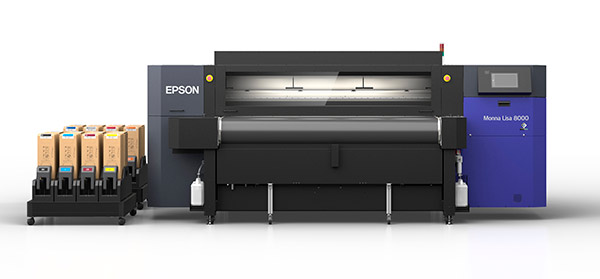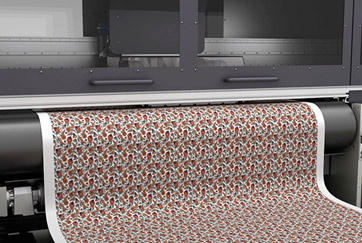
The ML-8000 is a new addition to the digital textile printing landscape. Equipped with eight newly developed PrecisionCore printheads, it packs the power and performance of world-class Epson inkjet printing and manufacturing technologies into an accessible entry-level package. Offering unprecedented performance and usability, it is a next-generation digital textile printer that will take production capabilities to a new level.
FEATURES AT A GLANCE
- Exceptionally high print quality on a range of fabrics
- 8 PrecisionCore Micro TFP printheads
- Epson precision dot technology
- Multi-Layer Halftone Technology (MLHT)
- Dynamic Alignment Stabiliser (DAS) Technology
- Symmetrical colour alignment
- Accurate Belt Position Control (ABPC) Technology
- Stable operation / Easy maintenance
- Fluff blower system
- Ink mist extraction system
- Nozzle Verification Technology (NVT)
- Auto nozzle cleaning by fabric wiper
- Built-in RGB camera for auto calibration
- Epson Cloud Solution PORT
- Easy operation
- 9-inch LCD touch panel
- Dual 10-litre or 3-litre high-capacity ink cartridges
High print quality and productivity
The ML-8000 boasts a typical print speed of 162 square metres per hour (2-pass printing at 600 x 600 dpi). Epson precision dot technologies include Microweave and lookup table (LUT) technologies that reduce banding and graininess, and advanced new Multi-Layer Halftone Technology (MLHT) that randomises the halftone dot pattern to reduce image degradation caused by dot misalignment. Dynamic Alignment Stabiliser (DAS) technology also ensures stable print quality by controlling waveforms on each printhead chip for higher dot placement accuracy and more uniform dot density on each pass. The ML-8000 also features symmetrical colour alignment for consistent colour overlap order during high-speed bidirectional printing, and Accurate Belt Position Control (ABPC) technology for precise fabric feeding. The result is optimal quality and speed, with superb reproduction of colour gradations, fine details, and complex geometric patterns.
Stable operation with minimal downtime
Stable operation and unprecedented usability are realised by advanced cleaning mechanisms and automated adjustment functions. A fluff blower system removes fluff from the fabric surface before it enters the printing area, and an ink mist extraction system helps reduce nozzle clogging problems. In the event a nozzle does become clogged, Nozzle Verification Technology (NVT) detects missing dots and adjusts ink delivery to maintain image quality and reduce printing errors. Auto nozzle cleaning by fabric wiper reduces daily manual maintenance work. With high-accuracy head alignment technology and automatic calibration by the built-in RGB camera, printhead replacement and calibration can be completed easily. In addition, the Epson Remote Monitoring System reduces downtime and service calls by allowing quick response to potential problems.
Easy operation

Ease of use is enhanced by a 9-inch LCD touch panel that displays current printer status, operating instructions, and regular maintenance procedures, and by hot-swappable, dual 10-litre or 3-litre high-capacity ink cartridges that allow uninterrupted production.
Environmentally friendly GENESTA Ink
Epson GENESTA inks are Pigment formulations, and are ECO PASSPORT certified to meet globally recognised standards for environmentally friendly textile printing. Our Acid ink is also bluesign® approved, and our Reactive and Pigment inks are GOTS approved by ECOCERT.
Software for digital textile printing

Our original RIP software, Epson Edge Print Textile, has an intuitive interface for easy, 3-step, left-to-right operation, as well as step & repeat, hot folders, colour replacement for matching spot colours, and other convenient features. Optional ColorBlend preprocessing software also lets you create colour variations (colorways), control ink penetration to achieve visual equivalence on both sides of fabric, generate ICC profiles, and perform other preprocessing task
